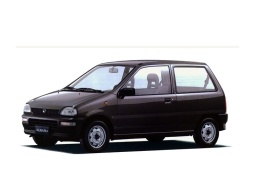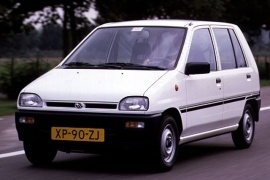SUBARU Mini Jumbo Models/Series Timeline, Specifications & Photos
First production year: 1988
Engines: Gasoline
Body style: Hatchback
The kei-car segment was huge in the Japanese market, and Subaru was a big player in that. But for other countries, it built a version of its Rex/Mini Jumbo with bigger engines.
A kei-car had to obey a specific set of rules, including size and engine displacement. That evolved into a car-culture almost unknown in other countries. But the same vehicles were suitable for heavy traffic use and minimal parking spaces. For those markets, Subaru built similar cars, but with engines that exceeded the kei-car book. In 1988, it launched the Mini Jumbo for the export market, and it was a success.
Apart from one or two vehicles, Subaru didn't design award-winning cars. Like a cube on tiny wheels, the Rex, or Mini Jumbo, was just a wedged-shaped vehicle. Its angular look inspired a cheap production process, with fewer stamps than most other cars from the market. But the cubist design, with a raked hood and straight side panels, made it look like a box on wheels with rectangular headlights. Its three-door version was a good choice since it allowed easier access for the front occupants.
The interior continued the straight-lines design theme from the outside. Subaru installed eight buttons for various functions on the instrument cluster's sides, such as the lights or the rear window defroster. At least, the horn was in the center of the steering wheel. The Rex/Mini Jumbo could fit up to four people inside but with limited rear passengers' legroom.
Subaru offered the Rex/Mini Jumbo with a two or four-cylinder engine. That's right: two cylinders for the base version. Later on, a supercharged version was introduced on the market. The carmaker offered the small vehicle with either a front- or all-wheel-drive system.
Subaru built the Rex/Mini Jumbo as a kei car for the Japan Domestic Market but exported it with larger engines on some other markets.
The internal market was vital for Subaru. Since the Japanese regulations offered good incentives for kei-cars, Subaru offered the Rex since 1972. In 1986 the car already reached its third generation, and it was refreshed just two years later.
Apart from one or two vehicles, Subaru didn't design award-winning cars. The Rex, or Mini Jumbo, was just a wedged-shaped vehicle, like a cube on tiny wheels. Its angular look inspired a cheap production process, with fewer stamps than most other cars from the market. But the cubist design, with a raked hood and straight side panels, made it look like a box on wheels with rectangular headlights.
The interior continued the straight-lines design theme from the outside. Subaru installed eight buttons for various functions on the sides of the instrument cluster, such as the lights or the rear window defroster. At least, the horn was in the center of the steering wheel. The Rex/Mini Jumbo could fit up to four people inside but with limited legroom.
Subaru offered the Rex/Mini Jumbo with a two or four-cylinder engine. That's right: two cylinders for the base version. Later on, a supercharged version was introduced on the market. The carmaker offered the small vehicle with either a front- or all-wheel-drive system.

